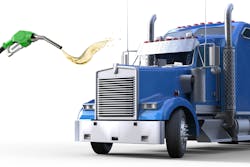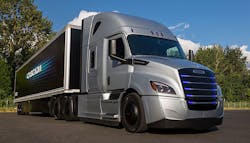Why we shouldn't, and can't ever, do away with diesel 18-wheelers
By Bill Siuru, technical editor for Green Car Journal
I live close by I-10 near Riverside, California. The Interstate is jammed with trucks hauling medical supplies, food and other items vital to the coronavirus crisis. It's fortunate that these trucks are diesel powered. Environmentalists and politicians are advocating replacing fossil fuels like diesel with renewable sources of energy sources like electricity and hydrogen. They contend battery-electric and fuel cell heavy-duty trucks could replace diesel rigs; they already are albeit on a limited scale in some applications. However, long-distance, over-the-road trucking is not one of these applications, and probably never will be.
Real-world applications
Freightliner has already delivered two of eCascadia Class 8 electric semis to a customer and the trucks should be in series production beginning in 2021. Peterbilt has built a dozen all-electric Model 579 day cab tractors for drayage duty at the Port of Long Beach. A BYD 8TT Class 8 electric tractor is delivering Anheuser-Busch beer in the San Francisco area. Tesla is developing a battery-powered Class 8 semi tractor that it says will be in limited production by late 2020. Volvo plans to have its VNR Electric day cab semi available in California by the end of the year.
One thing these electric trucks have in common is their short range between recharges. These range from about 250 miles for the Freightliner eCascadia to 500 miles for the Tesla tractor with the largest battery. This is definitely not enough miles for the typical diesel tractor whose range is 1,000 to 1,500 miles between refueling stops. Add the time to recharge batteries and you see why today's crop of electric semis might be okay for local hauling, they definitely aren't suitable for long distance hauling. For example, Freightliner says it takes 90 minutes of charging of the eCascadia to add 200 miles of range.
Why not add larger batteries? The energy stored in a battery is measured in kilowatt-hours (kWh). The energy stored in a gallon of diesel is equivalent to 37.85 kWh stored in batteries. To store the same amount of energy contained in the 200 to 300 gallons typically carried aboard a semi would require 7,570 to 11,355 kWh. Since electric motors are about three times more efficient than diesel engines, only about 2,523 to 3,785 kWh would be required to equal 200 to 300 gallons of diesel. For reference, the lithium-ion battery in the Freightliner eCascadia is rated at 550 kWh.
Using the best-state-of-art lithium-ion battery technology, the above batteries would weigh about 18,500 to 27,800 pounds. In comparison, 200 and 300 gallons of the diesel weighs about 1,400 to 2,000 pounds, so an electric 18-wheeler would carry 17,100 to 25,800 pounds less payload than a comparable diesel truck.
Time to recharge is a killer. Compared to the about 15 minutes it takes to tank up with diesel, recharging a huge battery in a semi would take many hours. Normally, lithium-ion batteries are charged from 10% to 80% state-of-charge (SOC). Letting a battery discharge below 10% SOC can be hard on batteries and after 80% SOC charging can slow to a trickle. Assuming fast charging at 350 kilowatts, capability now being deployed, it would take 5 hours to recharge a 2,500 kWh battery for about 1,000 miles of range and 7.5 hours for a 3,750 kWh one for 1500 miles. If today, most of the 18-wheelers carrying vital supplies were electric powered, truck stops with charging stations would be long term parking lots.
The Hydrogen solution
Another way to achieve zero-emission trucking is to replace diesel engines with hydrogen fuel cells and diesel fuel tanks with hydrogen tanks. There is not big difference in weight so payload is not compromised. Nikola is offering both Nikola One battery-electric and Nikola Two hydrogen fuel cell semi tractor trucks, Anheuser-Busch has ordered up to 800 of the hydrogen semi trucks with first deliveries in 2020. Two prototypes are already delivering Budweiser beer. Nikola claims the Nikola Two has a range of 500 to 750 miles and can be refilled with hydrogen in 10 to 15 minutes. Kenworth and Toyota are developing 10 zero-emissions Kenworth T680s powered by Toyota hydrogen fuel cell electric powertrains that will be used at Port of Los Angeles.
The downside to hydrogen fuel cells is the current lack of a refueling infrastructure. Today, there are only 47 hydrogen stations, of which 42 are in California. This compares to about 25,000 electric charging station across the U.S. Nikola is planning to build 7000 hydrogen filling stations to support its fuel cell OTR trucks. It doubtful that an investment in a hydrogen infrastructure that parallels the electric one will be made in the near future. Thus, hydrogen fuel cell trucks will be used mainly on dedicated routes, leaving the diesel to make deliveries everywhere deliveries have to be made.
While electric and fuel cell semis may not be practical for long-distance OTR duty, there are other technologies that could achieve zero or near zero net CO2 emission. Today, there is much interest in CO2 Capture (CS) and CO2 Capture and Conversion (CCS). In simple terms, CS involves removing CO2 produced by various sources – powerplants, vehicles or the atmosphere - and sequestering, that is storing it, where in will not enter the atmosphere. Typically, this would be in a underground geological formation. Capture and conversion takes the process one step further by converting the captured CO2 into fuel and other carbon products.
Global scale
There are hundreds of CS and CSS projects currently underway worldwide. One example of CSS technology that could directly achieve net zero CO2 emissions from fossil fueled vehicles comes from Ecole Polytechnique Federale de Lausanne in Switzerland. Researchers at EPFL have patented a concept that captures CO2 in a truck's exhaust and liquefies it in a box on the roof. The liquid CO2 would then be delivered to a facility where it would be turned back into fuel using renewable energy.
The COVID-19 pandemic is making a loud statement about the importance of the nation's diesel trucking fleet as well as both company and owner-operator drivers. Hopefully, environmentalists and politicians get the message, so rather than choosing a solution like banning fossil fuels, they set the goals for reducing CO2 in the atmosphere and let the scientists, engineers and manufacturers find the best way to meet these goals.
Bill Siuru is a retired USAF colonel and is now the technical editor for the Green Car Journal. He has a PhD in mechanical engineering, and taught engineering at West Point and the U.S. Air Force Academy.

